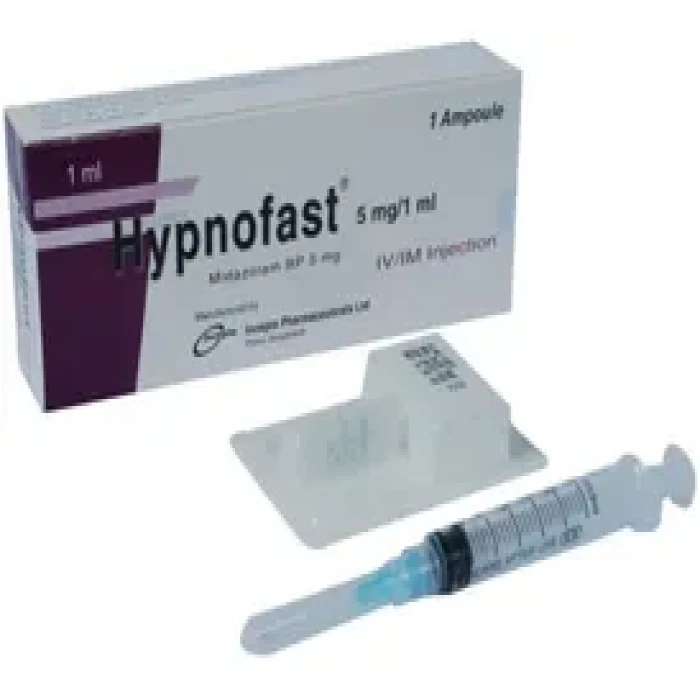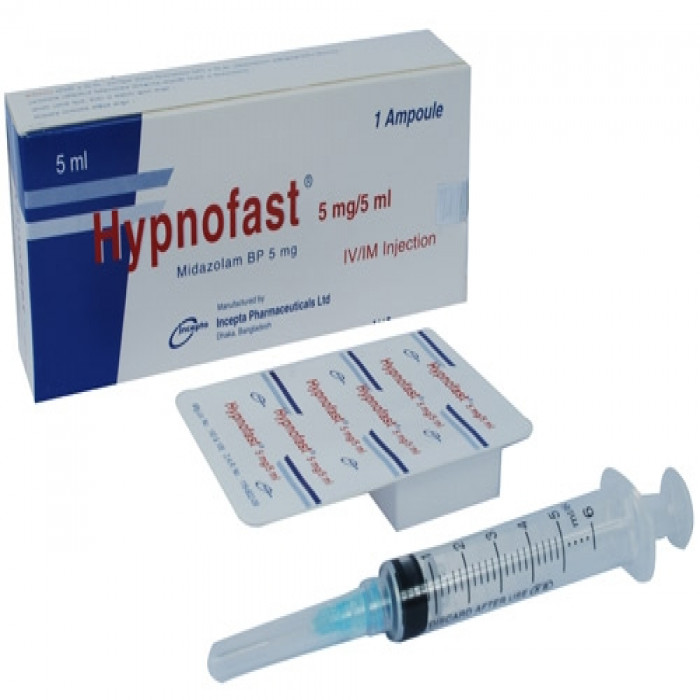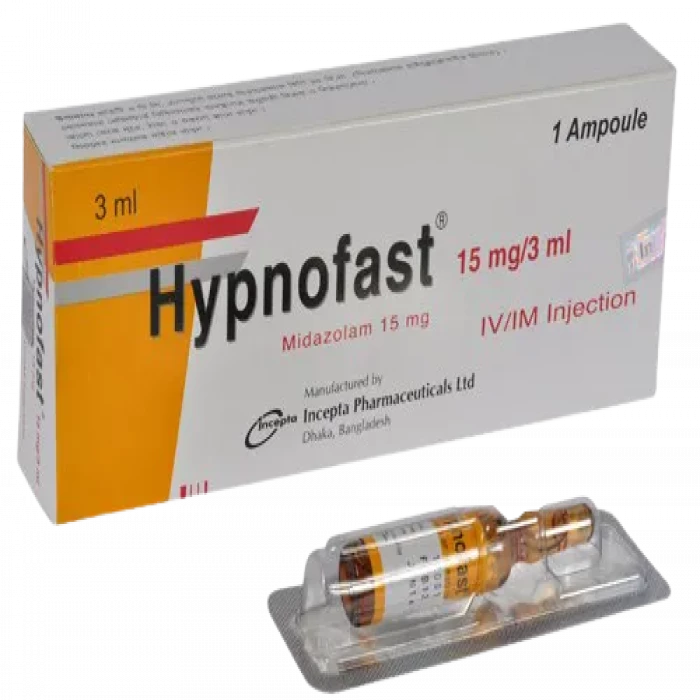
✔ 100% Authentic Product
👁️ Currently Viewing 1794
Hypnofast Injection 5mg/1ml
Injection, Generic Name: Midazolam HCl, Manufacturer: Incepta Pharmaceuticals Ltd.
Discount
Price: ৳ 86
MRP:
৳
90
5%
Off

100% Genuine Products, Guaranteed

Safe & Secure Payments, Always

Fast, Secure & Efficient Delivery

Proper Packaging
 Cash on Delivery - All over Bangladesh
Cash on Delivery - All over Bangladesh Regular Delivery - 12-24 Hours, Dhaka City* Charge Tk.39-59
Regular Delivery - 12-24 Hours, Dhaka City* Charge Tk.39-59 Regular Delivery - 24-48 Hours, Other Cities* Charge Tk.99-110
Regular Delivery - 24-48 Hours, Other Cities* Charge Tk.99-110
 ফ্রি ডেলিভারিঃ - ৯৯৯ টাকা+ অর্ডারে, ঢাকা
শহরে
ফ্রি ডেলিভারিঃ - ৯৯৯ টাকা+ অর্ডারে, ঢাকা
শহরে ফ্রি ডেলিভারিঃ - ২৯৯৯ টাকা+ অর্ডারে, ঢাকার
বাহিরে
ফ্রি ডেলিভারিঃ - ২৯৯৯ টাকা+ অর্ডারে, ঢাকার
বাহিরে
100% Genuine Products, Guaranteed
Safe & Secure Payments, Always
Fast, Secure & Efficient Delivery
Proper Packaging
 Cash on Delivery - All over Bangladesh
Cash on Delivery - All over Bangladesh Regular Delivery - 12-24 Hours, Dhaka City* Charge Tk.39-59
Regular Delivery - 12-24 Hours, Dhaka City* Charge Tk.39-59 Regular Delivery - 24-48 Hours, Other Cities* Charge Tk.99-110
Regular Delivery - 24-48 Hours, Other Cities* Charge Tk.99-110 ফ্রি ডেলিভারিঃ - ৯৯৯ টাকা+ অর্ডারে, ঢাকা
শহরে
ফ্রি ডেলিভারিঃ - ৯৯৯ টাকা+ অর্ডারে, ঢাকা
শহরে ফ্রি ডেলিভারিঃ - ২৯৯৯ টাকা+ অর্ডারে, ঢাকার
বাহিরে
ফ্রি ডেলিভারিঃ - ২৯৯৯ টাকা+ অর্ডারে, ঢাকার
বাহিরে
✅ Description:
Hypnofast is a prescription medicine used as a sedative or for conscious sedation before diagnostic or therapeutic procedures. It relieves anxiety and muscle tensions, thus making the person comfortable before investigations or minor surgical or dental procedures. Hypnofast reduces anxiety and causes drowsiness. It comes in the form of a nasal spray and taken under the supervision of a healthcare professional only or can be used after the proper guidance of a doctor. Take this medicine in the dose and duration as advised by your doctor as it has a high potential of habit-forming. If you have missed a dose, take it as soon as you remember it and finish the full course of treatment even if you feel better. It is important that this medication is not stopped suddenly without talking to your doctor as it may cause nausea and anxiety. Side effects of this medicine include headache, nasal discomfort, throat irritation, and rhinorrhea. It may also cause dizziness and sleepiness, so do not drive or do anything that requires mental focus until you know how this medicine affects you. However, these side effects resolve on their own usually. Please consult your doctor if these bother you or do not go away. If you have been taking this medicine for a long time then regular monitoring of blood and liver function may be required. Please inform your doctor if you are pregnant, planning to conceive or breastfeeding, before taking this medicine.
Uses of Hypnofast
- Conscious sedation during diagnostic or therapeutic procedures
Side effects of Hypnofast
Common
- Nasal discomfort
- Throat irritation
How to use Hypnofast
Use this medicine in the dose and duration as advised by your doctor. Check the label for directions before use. Insert the bottle tip into one nostril and close the other nostril. Direct the spray towards the sides of your nostril, away from the cartilage dividing the two sides of your nose. As you spray, breath gently and keep the head upright. Repeat the same process for the other nostrils.
How Hypnofast works
Hypnofast is a benzodiazepine (BZD). It is rapidly absorbed into the bloodstream through the inner lining of the nose. Once absorbed, it works by increasing the action of GABA, a chemical messenger which suppresses the abnormal and excessive activity of the nerve cells in the brain. This helps the patient to recover from a seizure faster.
What if you forget to take Hypnofast?
If you miss a dose of Hypnofast, take it as soon as possible. However, if it is almost time for your next dose, skip the missed dose and go back to your regular schedule. Do not double the dose.

Quick Tips
- The addiction / habit-forming potential of this medicine is very high. Take it only as per the dose and duration advised by your doctor
- It may cause dizziness. Do not drive or do anything that requires mental focus until you know how this medicine affects you.
- Avoid consuming alcohol as it may increase dizziness and drowsiness.
- Inform your doctor if you are pregnant, planning to conceive or breastfeeding.
- Do not stop taking medication suddenly without talking to your doctor as that may lead to nausea, anxiety, agitation, flu-like symptoms, sweating, tremor, and confusion.

Brief Description
Indication
Short-term treatment of insomnia. Sedation in premedication before surgical or diagnostic procedures.
Administration
May be taken with or without food. Midazolam IV should be administered very slowly.
Adult Dose
Adult Oral Short-term management of insomnia Adult: 7.5-15 mg at bedtime. Elderly: 7.5 mg at bedtime. Hepatic impairment: Mild to moderate: Dosage reduction needed. Severe: Contraindicated. Parenteral Preoperative Sedation IM Adult: 0.07-0.1 mg/kg bodyweight i. m. Usual dose is about 5 mg. Elderly and debilitated patients: 0.025-0.05 mg/kg IV Endoscopic or Cardiovascular Procedures In healthy adults the initial dose is approximately 2.5 mg. In cases of severe illness and in elderly patients, the initial dose must be reduced to 1 to 1.5 mg. Induction of Anesthesia The dose is 10-15 mg I. V.
Child Dose
Oral Seizures Child: 3-6 mth Hospital setting: 2.5 mg; >6 mth to <1 yr 2.5 mg; 1-<5 yr 5 mg; 5-<10 yr 7.5 mg; 10-<18 yr 10 mg. Doses are given as single dose. Sedation 500-750 mcg/kg PO once diluted by juice 20-30 minutes prior to procedure; not to exceed 20 mg Rectal administration in children: For preoperative sedation, rectal administration of the ampoule solution (0.35-0.45 mg/kg) 20-30 min before induction of general anesthesia. Parenteral Sedation IM 100-150 mcg/kg IM; up to 500 mcg/kg used; not to exceed 10 mg IV <6 months: Initial, 50 mcg/kg IV over 2-3 minutes; titrate with small increments to clinical effect; monitor closely 6 months-6 years: Initial, 50-100 mcg/kg IV over 2-3 minutes; repeat q2-3min PRN; may require up to 600 mcg/kg total dose; not to exceed 6 mg total dose 6-12 years: Initial, 25-50 mcg/kg IV over 2-3 minutes; repeat q2-3min PRN; may require up to 400 mcg/kg; not to exceed 10 mg total dose Anesthesia (Non-neonatal) Loading dose: 50-150 mcg/kg IV over 2-3 minutes PRN to achieve desired effect Continuous infusion: 1-2 mcg/kg/min IV infusion Anesthesia (Neonatal) IV loading dose should not be used in neonates Continuous infusion: 0.5 mcg/kg/min IV infusion
Contraindication
Severe resp failure or acute resp depression, acute narrow-angle glaucoma, myasthenia gravis, sleep apnoea syndrome; severe hepatic impairment (oral). Concomitant use w/ potent CYP3A4 inhibitors.
Mode of Action
Midazolam is a short-acting benzodiazepine. It exerts sedative and hypnotic, muscle relaxant, anxiolytic and anticonvulsant actions. While the probable anxiolytic action might be as a result of the drug's ability to increase glycine inhibitory neurotransmitter level, the hypnotic/anaesthetic action may be due to the occupation of the benzodiazepine and GABA receptors leading to membrane hyperpolarisation and neuronal inhibition, and further interfering with the re-uptake of GABA at the synapses.
Precaution
Patients w/ heart failure, impaired gag reflex, resp disease, history of alcohol or drug abuse. Patient at risk of falls. Hepatic and renal impairment. Childn, elderly and debilitated patient. Pregnancy and lactation. Avoid abrupt withdrawal after prolonged use. Avoid rapid inj in neonates. Patient Counselling May impair ability to drive or operate machinery. Monitoring Parameters Monitor resp and CV status, BP. Lactation: Distributed in breast milk, use caution
Side Effect
>10% Decreased respiratory rate (23%),Apnea (15%) 1-10% Drowsiness (1-5%),Seizure-like activity (1%),Nausea/vomiting (3%),Cough (1%),Pain at injection site (4-5%) Frequency Not Defined Headache,Sedation,Hiccoughs,Delirium,Euphoria Pediatric Desaturation,Hypotension,Seizurelike activity,Nystagmus,Paradoxical reactions,Hiccoughs,Apnea
Pregnancy Category Note
Midazolam should be avoided during pregnancy unless there is no safer alternative. Since Midazolam passes into breast milk, it should not be administered to breast-feeding mothers.
Interaction
Increased CNS depression with alcohol, opioids, barbiturates, other sedatives and anaesthetics. Increased respiratory depression with opiates, phenobarbital, other benzodiazepines. Plasma concentrations increased by CYP3A4 inhibitors such as cimetidine, erythromycin, clarithromycin, diltiazem, verapamil, ketoconazole and itraconazole, antiretroviral agents, quinupristin with dalfopristin. Midazolam concentration decreased by phenytoin, carbamazepine, phenobarbital, rifampicin. Halothane, thiopental requirements may be reduced during concurrent use.
⚠️Disclaimer:
At ePharma, we’re committed to providing accurate and accessible health information. However, all content is intended for informational purposes only and should not replace medical advice from a qualified physician. Please consult your healthcare provider for personalized guidance. We aim to support, not substitute, the doctor-patient relationship.








